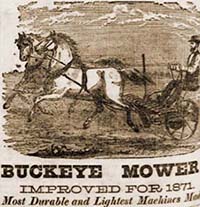 |
|||||||||||
|
|||||||||||
Aurora, Hamilton County, Nebraska |
|||||||||||
| Selections from Biographical and Historical Memoirs of Adams, Clay, Hall and Hamilton Counties, The Goodspeed Publishing Company, Chicago, Illinois, 1890 | |||||||||||
|
...In March, 1871, a town company was formed at Chariton, Iowa, who proposed to go to Hamilton County, Neb., and locate a town which should become the county seat. They entered into the following agreement with each other. This agreement, made and entered into this 9th day of March, 1871, by and between David Stone, Darius Wilcox, Robert Miler, James Foremuch, J. Ray, N. H. Thorpe, S. P. Lewis, of Lucas County, Iowa, for the purpose of securing a title to Section 4, Town 10, Range 6 west. [In 1871 the John Long family settled in Hamilton County on a homestead two miles from Aurora.] ...It is agreed that David Stone be selected as a suitable person to visit Hamilton County, Nebraska... to homestead in the name of the eight individual members of the company...each party to this contract will, at the signing of the same, pay to said Stone the sum of thirty dollars. He arrived at S. W. Spafford's place on Lincoln Creek, and after an examination of the county returned to Iowa. Disunion, however, arose in the organization and the plans of the town company came to naught. The original town site was surveyed and platted by Darius Wilcox and Mary A. E. Stone, and entered for record December 20, 1872....and entered as a town site May 25, 1874, by Edgar D. Preston, Darius Wilcox, F. M. Ellsworth, Rebecca E. McPherson and Mary A. E. Stone. ...In June, 1871, the town company erected the first house upon Section 4, a "dug-out," on the site now occupied by Chapman's agricultural implement store - the southwest corner, Block 12, original town. In August of the same year David Stone erected the first frame building in the town, a store and residence, in which he opened the first stock of general merchandise brought to the new place. ... In 1872 the school-house (the building now used as a Catholic Church) was built, also the Aurora House... It was incorporated as a village on July 3, 1877, John Helms, D. Bates, W. H. Streeter, John Raben and Harry W. Kemper being appointed trustees. The first meeting of the board was held July 5, 1877, and John H. Helms was elected president, and W. L. Whittemore appointed clerk. For two years more the town struggled along, enduring all the inconvenience of lack of railroad and telegraph communication, until the fall of 1879, when it had attained a population of scarcely 400. With the advent of the Republican Valley Railroad, a branch of the Burlington & Missouri River in Nebraska, which ran its first regular train into the town October 14, 1879, a great forward stride was made, and a period of activity ensued which rapidly carried the town into rank with her neighbors in surrounding counties which had had the advantage of railroad facilities at an earlier date. From this time on the growth of the city has been steady and continuous, and while there has never been what is commonly called a boom... The number of children of school age in 1889 in the district was 652, about 500 being the average attendance. The high standing in scholarship attained by the pupils in the different departments speaks volumes of the efficiency of the teachers. The first Congregational Church of Aurora was organized by Rev. D. B. Perry, April 27, 1872. Rev. Perry was a missionary sent out by the Home Missionary Society, and is one of the pioneer missionaries of Hamilton County... The First Baptist Church of Aurora was organized in May, 1872, by Rev. Mr. Biggart, who became its first pastor, his ministry covering a period of two years. .. The Catholic mission was established at Aurora in 1876 by Rev. Father Glauber, then stationed at Hastings, and attended by him at intervals until he was succeeded by Rev. Father Eugene Geary. Father Geary was succeeded in March, 1889, by Rev. Adams. ... In the winter of 1872-73, Rev. W. J. Witso organized the Methodist Church at Aurora. Rev. C. L. Smith was the first minister appointed to take charge of this circuit... The Presbyterian Church of Aurora was organized August 16, 1873, by Rev. N. C. Robinson, synodical missionary of Nebraska, and was incorporated as a society March 9, 1878... Initiatory steps were taken in the fall of 1878 to organize a German Evangelical Church in Aurora, services being held by Rev. S. H. Holdgraf, at the houses of German citizens. The church was organized on January 13, 1879, with Rev. Holdgraf as pastor... The Aurora Free-Will Baptist Church was organized in May, 1879, by Rev. A. M. Totman, Rev. G. T. Davis and Rev. Mr. Totman ... In July, 1887, Elder John T. Smith, of Nebraska City, State evangelist, came to Aurora and began a series of meetings with a view to organize the Disciples, in this vicinity, into a congregation. He preached about two weeks, holding meetings in the Free Baptist, Presbyterian and Congregational Churches. During this time he secured the names of about forty who had been members of the church prior to removing to this place, and after arranging for the use of the court-room for Sunday-school and church services, the congregation was organized on July 31, 1887...
|
|
|||||||||
|
|||||||||||
|
©Roberta Tuller 2023
|
|||||||||||

